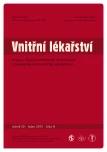Outcomes of Catheter Ablation of Atrial Fibrillation in Patients over 65 Years of Age
Authors:
M. Fiala 1,2; L. Škňouřil 1; O. Toman 2; J. Pindor 1; D. Wojnarová 1; V. Bulková 1; J. Chovančík 1; M. Dorda 1; H. Szymeczek 1; R. Neuwirth 1; D. Vavřík 1; Š. Krawiec 1; O. Jiravský 1; L. Rybka 2; R. Lábrová 2; J. Januška 1; J. Špinar 2
Authors‘ workplace:
Oddělení kardiologie Nemocnice Podlesí, a. s., Třinec, přednosta prim. MUDr. Marian Branny
1; Interní kardiologická klinika Lékařské fakulty MU a FN Brno, pracoviště Bohunice, přednosta prof. MUDr. Jindřich Špinar, CSc., FESC
2
Published in:
Vnitř Lék 2013; 59(1): 16-22
Category:
Original Contributions
Overview
Purpose:
This study assessed ablation techniques, recurrent arrhythmias, long-term outcomes, and complications of catheter ablation for atrial fibrillation (AF) in patients ≥ 65 years of age.
Methods:
Consecutive patients aged < 65 years (n = 653) vs ≥ 65 years (n = 213), who underwent catheter ablation of AF in the course of eight years, were compared. Ablation strategy and procedure endpoints were left at the operator’s discretion.
Results:
The group of patients ≥ 65 years comprised more females (p < 0.001), and more frequently presented with persistent AF (p = 0.010). These patients less frequently underwent simple pulmonary vein isolation (p = 0.017); on the contrary, extensive ablation including coronary sinus intervention was more common (p = 0.020). There was no difference in repeat ablation procedures (25 % vs 26 % patients; p = 0.823, or 1.4 vs 1.5 ablation procedures/1 patients; p = 0.479, respectively). Spectrum of recurrent arrhythmias did not differ between the groups except for more frequent paroxysmal AF before the first repeat ablation in patients < 65 years (p = 0.050). At the end of 49 ± 26 month total follow-up, stable sinus rhythm (SR) was achieved in 85 % patients < 65 years vs 76 % patients ≥ 65 years (p = 0.318). To maintain stable SR, older patients more often continued to take antiarrhythmic medication (p = 0.054). More serious complication occurred in 3.8 % of the patients ≥ 65 years vs 2.1 % of the patients < 65 years of age (p = 0.207).
Conclusion:
Patients ≥ 65 years of age achieved insignificantly worse long-term outcome after insignificantly fewer repeat ablation procedures, and with more frequent use of antiarrhythmic drugs. SR maintenance and risk of complications were, however, favorable.
Key words:
atrial fibrillation – catheter ablation – age – outcomes
Sources
1. Pappone C, Rosanio S, Augello G et al. Mortality, morbidity, and quality of life after circumferential pulmonary vein ablation for atrial fibrillation: outcomes from a controlled nonrandomized long-term study. J Am Coll Cardiol 2003; 42 : 185–197.
2. Wazni OM, Marrouche NF, Martin DO et al. Radiofrequency ablation vs. Antiarrhythmic drugs as first-line treatment of symptomatic atrial fibrillation: a randomized trial. JAMA 2005; 293 : 2634–2640.
3. Jais P, Cauchemez B et al. Catheter ablation versus antiarrhythmic drugs for atrial fibrillation: the A4 study. Circulation 2008; 118 : 2498–2505.
4. Wokhlu A, Monahan KH, Hodge DO et al. Long-term quality of life after ablation of atrial fibrillation: the impact of recurrence symptom relief, and placebo effect. J Am Coll Cardiol 2010; 55 : 2309–2316.
5. Pappone C, Vicedomini G, Augello G et al. Radiofrequency catheter ablation and antiarrhythmic drug therapy: A prospective, randomized, 4-year follow-up trial: The APAF Study. Circ Arrhythm Electrophysiol 2011; 4 : 808–814.
6. Bulková V, Fiala M, Haman L et al. Zlepšení kvality života po ablaci dlouhodobě perzistentní versus paroxysmální fibrilace síní: výsledky dvouletého sledování. Vnitř Lék 2011; 57 : 456–462.
7. Berruezo A, Tamborero D, Mont L et al. Pre--procedural predictors of atrial fibrillation recurrence after circumferntial pulmonary vein ablation. Eur Heart J 2007; 28 : 836–841.
8. Tzou WS, Marchlinski FE, Zado ES et al. Long-term outcome after successful catheter ablation of atrial fibrillation. Circ Arrhythm Electrophysiol 2010; 3 : 237–242.
9. The Atrial Fibrillation Follow up Investigation of Rhythm Management (AFFIRM) Investigators. A comparison of rate control and rhythm control in patients with atrial fibrillation. N Engl J Med 2002; 347 : 1825–1833.
10. The AFFIRM Investigators. Relationships between sinus rhythm, treatment, and survival in the Atrial Fibrillation Follow-up Investigation of Rhythm Management (AFFIRM) study. Circulation 2004; 109 : 1509–1513.
11. Fiala M, Chovančík J, Heinc P et al. Léčba symptomatické intermitentní fibrilace síní katetrovou ablací v levé srdeční síni: bezprostřední a dlouhodobé výsledky u 150 pacientů. Vnitř Lék 2005; 51 : 971–983.
12. Fiala M, Chovančík J, Nevřalová R et al. Pulmonary vein isolation using segmental versus electroanatomical circumferential ablation for paroxysmal atrial fibrillation: over 3-year results of a prospective randomized study. J Interv Card Electrophysiol 2008; 22 : 13–21.
13. Fiala M, Chovančík J, Nevřalová R et al. Termination of long-lasting persistent versus short-lasting persistent and paroxysmal atrial fibrillation by ablation. Pacing Clin Electrophysiol 2008; 31 : 985–997.
14. Cappato R, Calkins H, Chen SA et al. Updated worldwide survey on the methods, efficacy, and safety of catheter ablation for human atrial fibrillation. Circ Arrhythm Electrophysiol 2010; 3 : 32–38.
15. Fiala M, Chovančík J, Wojnarová D et al. Results of complex left atrial ablation of long-lasting persistent atrial fibrillation. J Interv Card Electrophysiol 2008; 23 : 189–198.
16. Bunch TJ, Weiss JP, Crandall BG et al. Long-term clinical efficacy and risk of catheter ablation for atrial fibrillation in octogenarians. Pacing Clin Electrophysiol 2010; 33 : 146–152.
Labels
Diabetology Endocrinology Internal medicineArticle was published in
Internal Medicine

2013 Issue 1
Most read in this issue
- Drug induced osteoporosis
- Risk factors for relapsing and severe Clostridium difficile infection
- Specificities of the diagnostics and therapy of exocrine pancreatic insufficiency
- Outcomes of Catheter Ablation of Atrial Fibrillation in Patients over 65 Years of Age
